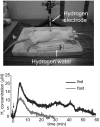Recent progress toward hydrogen medicine: potential of molecular hydrogen for preventive and therapeutic applications
- PMID: 21736547
- PMCID: PMC3257754
- DOI: 10.2174/138161211797052664
Recent progress toward hydrogen medicine: potential of molecular hydrogen for preventive and therapeutic applications
Abstract
Persistent oxidative stress is one of the major causes of most lifestyle-related diseases, cancer and the aging process. Acute oxidative stress directly causes serious damage to tissues. Despite the clinical importance of oxidative damage, antioxidants have been of limited therapeutic success. We have proposed that molecular hydrogen (H(2)) has potential as a "novel" antioxidant in preventive and therapeutic applications [Ohsawa et al., Nat Med. 2007: 13; 688-94]. H(2) has a number of advantages as a potential antioxidant: H(2) rapidly diffuses into tissues and cells, and it is mild enough neither to disturb metabolic redox reactions nor to affect reactive oxygen species (ROS) that function in cell signaling, thereby, there should be little adverse effects of consuming H(2). There are several methods to ingest or consume H(2), including inhaling hydrogen gas, drinking H(2)-dissolved water (hydrogen water), taking a hydrogen bath, injecting H(2)- dissolved saline (hydrogen saline), dropping hydrogen saline onto the eye, and increasing the production of intestinal H(2) by bacteria. Since the publication of the first H(2) paper in Nature Medicine in 2007, the biological effects of H(2) have been confirmed by the publication of more than 38 diseases, physiological states and clinical tests in leading biological/medical journals, and several groups have started clinical examinations. Moreover, H(2) shows not only effects against oxidative stress, but also various anti-inflammatory and antiallergic effects. H(2) regulates various gene expressions and protein-phosphorylations, though the molecular mechanisms underlying the marked effects of very small amounts of H(2) remain elusive.
Figures


References
-
- Ferrari R, Ceconi C, Curello S, Cargnoni A, Pasini E, Visioli O. The occurrence of oxidative stress during reperfusion in experimental animals and men. Cardiovasc Drugs Ther. 1991;5(Suppl 2):277–87. - PubMed
-
- Andersen JK. Oxidative stress in neurodegeneration: cause or consequence? Nat Med. 2004;10(Suppl):S18–25. - PubMed
-
- Ohta S, Ohsawa I. Dysfunction of mitochondria and oxidative stress in the pathogenesis of Alzheimer's disease: on defects in the cytochrome c oxidase complex and aldehyde detoxification. J Alzheimers Dis. 2006;9:155–66. - PubMed
-
- Ohta S, Ohsawa I, Kamino K, Ando F, Shimokata H. Mitochondrial ALDH2 deficiency as an oxidative stress. Ann N Y Acad Sci. 2004;1011:36–44. - PubMed
Publication types
MeSH terms
Substances
LinkOut - more resources
Full Text Sources
Other Literature Sources
Medical
